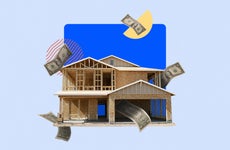Should you borrow from your builder? A guide to construction loans, homebuilder financing and preferred lenders

The Bankrate promise
At Bankrate we strive to help you make smarter financial decisions. While we adhere to strict , this post may contain references to products from our partners. Here's an explanation for .
If you’re a home buyer in today’s market, there’s a bit of good news: an influx of new construction. In response to the low levels of existing home inventory, residential builders are working to meet demand. In August 2023, new home sales in the U. S. made up 16.42 percent of total home sales, according to the National Association of Home Builders (NAHB) — an increase of 3.28 percent year-over-year.
On top of building the home, a residential developer often can help you buy it, too. Called home builder financing or preferred lending, getting a mortgage this way can mean a speedier closing, discounts and special perks for borrowers. However, it can also result in higher interest rates, more stringent qualifications and potentially more expensive loans overall.
So is it a good idea to finance your home purchase through a construction company? Here’s how borrowing from a builder works, and what you should know before filling out any applications.
What is home builder financing?
Home builder financing simply means a mortgage for a newly built home that’s offered through the construction company or developer. Some of the largest firms have their own standalone home-financing arm: National builder Toll Brothers, for example, provides loans through its subsidiary, Toll Brothers Mortgage Company. Other builders have ongoing partnerships/arrangements with independent mortgage companies or banks, known as their “preferred lenders.”
This can be a mutually beneficial relationship. However, to ensure there are no conflicts of interest, lenders must closely follow the terms of the Real Estate Settlement Procedures Act (RESPA), which dictates that they cannot legally receive kickbacks, referral fees or other unearned fees from the builder — or bestow them, either.
Home builder financing requirements
If you’re buying a production or a spec house — a move-in ready home built in a development before there’s a buyer — qualifying for a loan with a preferred lender is similar to getting a mortgage from any lender. You’ll likely be able to choose between a variety of financing products such as a conventional loan or FHA loan. These kinds of mortgages typically require a minimum down payment of 3 to 5 percent and a credit score of at least 620 (for conventional) or 580 (FHA). Some lenders even offer jumbo or other non-conforming loans.
If you aim to have a home custom-built, financing can be more complicated. You’ll need to get a construction loan (either independently or through a preferred lender), which can have stricter requirements, as well as higher fees. You’ll generally need a 20 percent down payment and a credit score of 680 for this sort of financing, though the terms can vary by lender.
Home builder financing deals
To encourage borrowers to use their financing, home builders often offer deals. In fact, nowadays “we are seeing incentives of some sort in most new construction developments,” says Patty Zuzek, real estate broker at Fieldstone Real Estate Specialists and vice president of sales and marketing for Fieldstone Family Homes in Minnesota. Through these deals, home buyers may be able to increase their buying power by financing through the home builder.
Financing incentives
Special offers may include upgrades for the home (like better appliances) or downgrades of the home price, a credit towards closing costs or a discount on the mortgage rate. The particular incentives the builder (or their preferred lender) offers are dependent on the type of construction and financing, according to Zuzek. For instance, a borrower going with a preferred lender’s FHA loan to buy a new home in an existing development will be offered different incentives than someone financing a custom-build on their own lot.
Mortgage rate buydowns
Home builder incentives are also highly market-driven, Zuzek says. For example, home builders are responding to current high interest rates by offering a mortgage rate buydown on new construction if you go with their preferred lender. Mortgage rate buydowns — also known as temporary buydowns — are discounts on loan interest rates. They involve the builder, lender and/or buyer paying upfront to knock percentage points off the interest rate for the first one to three years.
To get a buydown, “depending on which builder you work with, you’ll need to work with their preferred lender and their preferred title company,” says Zuzek. That’s because the lender pays for some portion of the buydown. Aspects like the borrower’s credit score and what type of mortgage they’re using will affect whether they’re offered a temporary buydown, she adds.
A temporary buydown can be a good option, but you need to be aware of the risk when the rate resets. “In general, buydown loans tend to end up at a much higher rate than what you’re going to get for a straight fixed [rate mortgage],” says Jeff Lazerson, President of Mortgage Grader, a mortgage brokerage in Laguna Niguel, California.
Still, they can be a shrewd move when mortgage rates are rising. “Right now the timing might not be too bad, as long as it’s a lender or builder-paid buydown,” Lazerson says. If mortgage rates fall in the next year or two, the buyer could refinance to a better rate after the buydown ends, he adds.
The pros of borrowing from a builder
1. Good interest rates
A big reason a borrower should consider borrowing home builder financing: cheaper loans. Pulte, for instance, is one of the nation’s largest home builders with their own mortgage company — Pulte Mortgage. As of this writing, Pulte is offering a 30-year fixed rate mortgage with an interest rate of 5.5 percent and an annual percentage rate (APR) of 5.69 percent. That interest rate is 1.62 percent below the current national average.
2. Home upgrades
One benefit of working with a preferred lender is you may be able to more easily upgrade the home. “The builders will allow you to finance improvements into the loan,” says Lazerson. The best reason to go with builder financing is when you want a significant amount of extras or customized features — such as top-of-the-line kitchen appliances or specialty flooring — but don’t have the money, according to Lazerson.
Because builders can pay for materials and labor at a reduced rate, the upgrade could be negotiable if you go with their preferred lender. You could get a better deal on a mortgage with an independent lender, but you’ll have to pay out of pocket for your own upgrades or take out a home renovation loan.
3. Streamlined mortgage process
Since builders work closely with a specific lender (or they’re owned by the same parent company), they can have more confidence that the loan will close if the borrower is approved. Builders don’t want to have a sale fall through at the last minute due to a hiccup in underwriting.
Every extra day they keep a finished home on their books is costing them, not only in taxes and maintenance, but in opportunity cost as well. With a preferred lender, the lender and the builder have strong reasons for the process to go smoothly. The builder benefits from selling the house and the lender benefits from the continued referral business. And of course, you the buyer could benefit from a faster and easier closing. It’s not guaranteed that you’ll get approved, of course, but your relationship with the builder certainly won’t hurt.
The cons of borrowing from a builder
1. Higher fees and costs
Going with a builder’s preferred lender can cost you more than going with an independent lender. “When you’re having to split your profits three ways — between the mortgage company, the builder and the loan officer — you just mark up the loan more because everyone’s got to get paid,” Lazerson says. That means a higher interest rate (after a buydown ends) and more fees.
Also note: for using their preferred lender, builders may throw upgrades like nicer flooring in for free. But, what they don’t tell you is that they inflate the value of these perks, according to Lazerson. “I don’t remember one time that a builder deal was cheaper than what the consumer could get through the mortgage broker,” he adds.
2. Stricter qualifications
To take advantage of some financing deals, you may have to meet stricter guidelines. For example, Pulte’s advertised APR of 5.69 (mentioned above) isn’t for everyone. The minimum credit score is 780 and you have to put at least 20 percent down. This rate is based on purchasing a $500,000 home. That means a minimum $100,000 down payment. The national median down payment for Q1 of 2023 was $24,100, according to Realtor.com. So, to qualify for this specific reduced APR, you’ll need to make a down payment that’s four times the national median down payment.
3. Limited choices
If you want to get discounts or other benefits from financing through a builder, you may be limited in the house you can buy. Obviously, it’s got to be one of the developer’s — and not all builders and lenders work in every area. Also, with some builders and preferred lenders, the discounts their offering may only apply to already-built homes in specific communities. If you want a different house or a different location, the discount may not work for you.
Should you use home builder financing?
It’s important to know that builders can’t require you to use their preferred lender. It’s just another option for buyers. “Asking the correct questions to the lender and the builder is really important,” says Zuzek. You want to know what to expect in terms of timeline, discounts and fees. And read the fine print on any and all incentives.
And, while going the preferred-lender route is certainly convenient — like getting an auto loan at the car dealership — studies show that shopping around saves money for mortgage-hunters. You should compare new construction mortgage rates from three different lenders, at least.
That way you’ll be able to make an educated decision as to whether the builder’s loan offer, with all its enticing incentives, is the best way to finance your new home.
Related Articles



